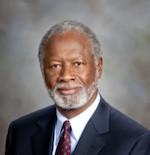House Speaker and Ohio Redistricting Commission co-chair Bob Cupp, center seated, speaks with House Minority Leader Allison Russo, right seated, as fellow co-chair state Sen. Vernon Sykes looks on. The ORC agreed to hire two outside mapmakers to assist in the process of legislative redistrict after a third set of maps was struck down by the Ohio Supreme Court. (Photo: Susan Tebben, OCJ)
A U.S. District Court decided Friday to wait on a decision to implement maps for the May primary election, as Ohio’s new mapmakers started work on the three major cities in the state.
A three-judge panel met to talk about a federal lawsuit brought by Republican Ohio voters, in which the panel is being asked to order the use of a third set of maps passed by the Ohio Redistricting Commission that were struck down by the Ohio Supreme Court.
Attorneys for those GOP voters want the third version of legislative maps to be used because they say there’s simply no time to implement a new map, even if those being created in a fourth attempt by the commission are approved and found to be constitutional.
“Who knows what’s going to happen Monday or Tuesday?” said Donald Brey, attorney for the GOP plaintiffs, a group that includes the head of anti-abortion lobby group Ohio Right to Life, Michael Gonidakis.
The ORC’s independent mapmakers, Michael McDonald and Douglas Johnson, have spent the past two days holed up in a Statehouse committee room working on districts in the three major counties.
In a progress report on Friday afternoon, the men said their work has produced nothing final as of yet, but McDonald said now that the major areas have been assessed, the pace should pick up as they approach their Monday deadline.
When asked when the commission could anticipate a full map to review, Johnson said it was hard to predict, but that they hope to have “working drafts” ready today, Saturday.
“That is a very ballpark estimate,” Johnson said.
Commission co-chair state Sen. Vernon Sykes also brought up the possibility of a Sunday public hearing on maps.
Brey and attorney Julie Pfeiffer, representing Ohio Secretary of State Frank LaRose, argued before the federal court that even if the commission were to approve a map by their March 28 deadline, the time the supreme court has allowed for objections to the map and responses to those objections, combined with the unknown amount of time the court will take to decide the case, create a tenuous situation for the May 3 primary, for which early voting is set to start April 5.
“Our primary concern is we don’t have a right to vote right now and our request for the temporary restraining order (allowing the use of the rejected maps) is the least disruptive … alternative to the other ones out there,” Brey said.
The judges seemed open to considering other options besides moving the primary date or using the rejected map, but were also of the opinion that a drama-free election season is impossible at this point.
“I think we can all agree we’re past the cost-free zone and the no-disruption zone,” Judge Benjamin J. Beaton said.
The court also agreed, as the ACLU argued they should, to wait to issue a decision on using the maps until LaRose answered a question about the limits in federal and state law on moving the start of early voting, implying they may be considering keeping the May 3 primary, with a delay to the start of voting.
Pfeiffer was asked about LaRose’s position on moving the primary date and for inserting a supplemental ballot, one that would include legislative races if a map was approved for voters and boards of elections to use.
“It is the secretary’s position that every day is of the essence,” Pfeiffer told the court.
The court asked the Secretary of State’s Office to provide more information on “drop-dead dates” for sending out supplemental ballots and holding the May primary, along with insight on when another primary would be held if the legislative races had to be conducted at a later date.
The next hearing is scheduled for March 30.
The Ohio Redistricting Commission is meeting through the weekend, with 4 p.m. meetings scheduled for both yesterday and today, and another meeting set for 10 a.m. tomorrow.
• • •• • •
This story is provided by Ohio Capital Journal, a part of States Newsroom, a national 501 (c)(3) nonprofit. See the original story here.




















